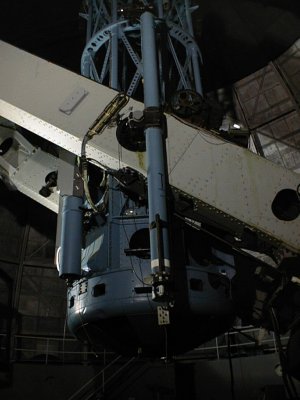Today, we look at some really big telescopes. The University of Houston's College of Engineering presents this series about the machines that make our civilization run, and the people whose ingenuity created them.
The astronomer George Ellery Hale was born in 1868 -- just after the Civil War. As a 24-year-old professor at the University of Chicago, he organized the Yerkes Observatory. There he built the largest telescope ever to use a conventional refractor lens. It was over three feet in diameter, but it was also something of a dinosaur.
You see, astronomers gave up conventional lenses in favor of focused mirrors after 1900. But Hale was no dinosaur. By 1904 he'd convinced Andrew Carnegie to give him $150,000 to set up the Mt. Wilson Observatory in California. Hale was downright greedy for high resolution and straightaway developed the largest mirror telescope ever built -- one five feet in diameter.
At first he joyfully cried, "With this we'll record ... a billion stars!" But by 1918 he was back at Carnegie's door for money to support a second mirror, more than 8 feet in diameter.
He was now only fifty, but his health had begun to fail him. He had to retreat from field work in astronomy. But that didn't stop him from planning, writing, and organizing. In 1916 he'd founded the National Research Council, which was very important in setting America's research agenda.
But one more telescope was on Hale's agenda -- a really big one. Andrew Carnegie was dead by now, but this time the Rockefellers gave $6,000,000 for a third mirror -- one almost seventeen feet in diameter -- the mirror that was to become the heart of the Mt. Palomar Observatory, also in California.
In 1934 the Corning Glass Company tried to make the first rough casting of this 17-foot mirror. They cooked a 50-foot lake of molten glass for six days at 2700°F. When they poured it into the mold, with the press watching, the inside of the mold broke up. Nine months later they tried again and succeeded. It took eight more months to cool it down. Grinding it by hand to within a millionth of an inch took years. The man who'd done this job on the eight-foot mirror had ended in a mental institution.
Hale died in 1938, and the Mt. Palomar telescope was finally finished ten years later. And, until the Russians made a larger one in 1986, it remained the grandest optical telescope. Compare its ninety-one inch focal length with the eight-inch focal length of your long-distance zoom lens. It finally took the new radio telescope to improve on its resolution.
A person has to be moved by the unmatched vision, nerve, and determination of this man. Just think: over a 56-year period, from the age of 24 until ten years after his death, George Ellery Hale gave us the world's largest telescope not once, but four times.
I'm John Lienhard, at the University of Houston, where we're interested in the way inventive minds work.
(Theme music)
Stirling, N., Wonders of Engineering. Garden City, N.J.: Doubleday and Company, Inc., 1966, Chapt. 11.
This episode has been substantially revised as Episode 1461.

(Photo by John Lienhard)
Hale's 100 inch (8 foot) lens is in the blue metal housing at the bottom.